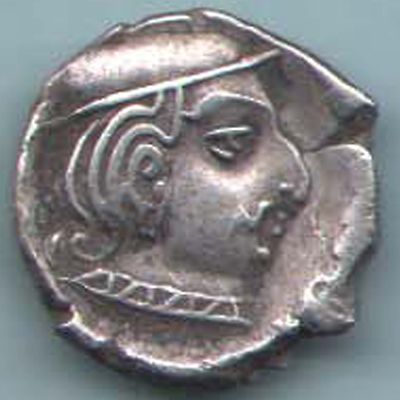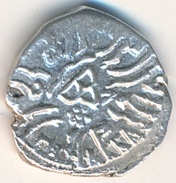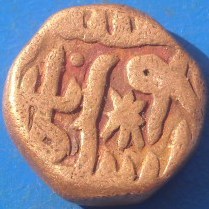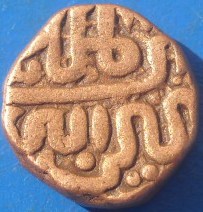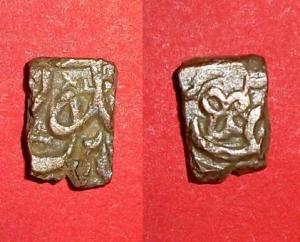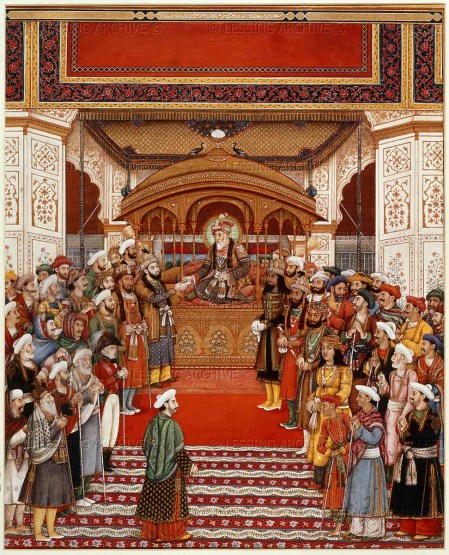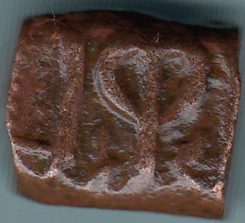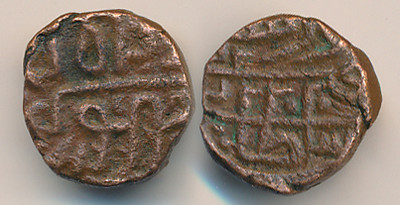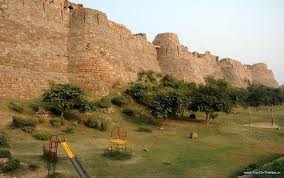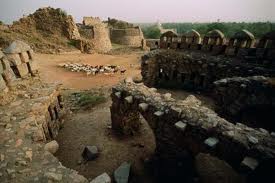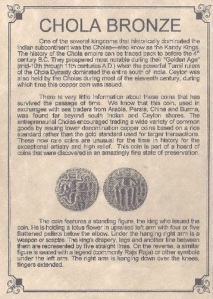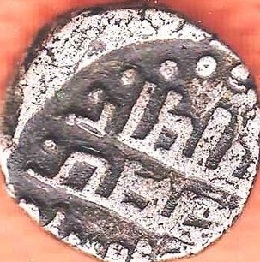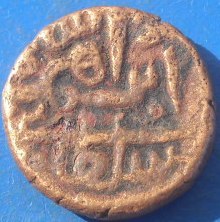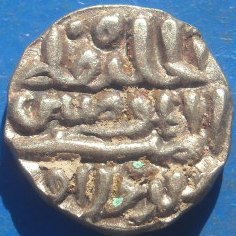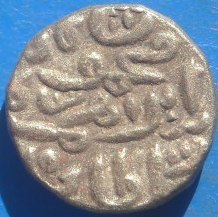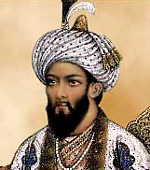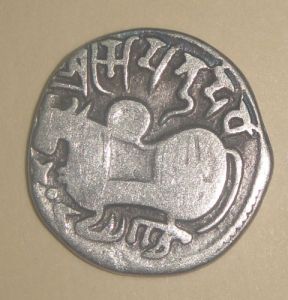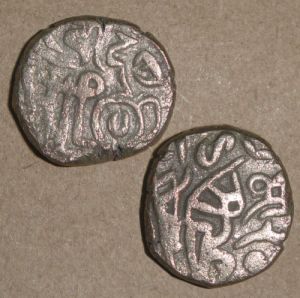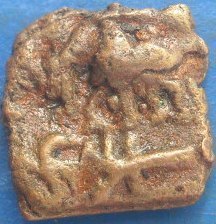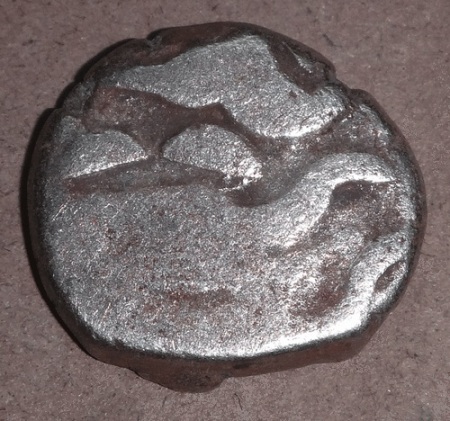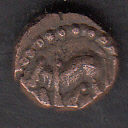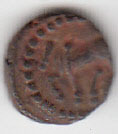Old Bronze Staters from Kashmir. The period is 979-1003 AD. Didda Rani is depicted on these coins. The Queen is depicted sitting cross legged on one side and standing on the other.
Queen Didda Rani (979 – 1003 AD)
AE Stater
Mitchiner NIS 177 – 178v.
18 mm.
5.92 gm.
Die position=11h
Obverse: Enthroned Ardoxsho facing; Nagari legend: ‘Sri’ left and ‘DiDda’ right.
Reverse: Queen standing.
Rulers of Kashmir issued chunky copper coins with very stylized designs showing the goddess Ardoxsho seated and the ruler standing. Our example bears the inscription of Didda Rani, one of the most ruthless queens that ever lived. After the death of her husband, she ruled through sons and grandsons killing them when they proved unsatisfactory until she assumed power (and issued coins) in her own name. After being the power behind and on the throne for over 50 years she died leaving the rule to her nephew (closest surviving relative). Coins of Kashmir can withstand much wear without losing legends. Finding coins with facial details and full legends is very hard but more ordinary specimens are extremely common. Our example lacks facial details and holds dirt in the recesses as is common for these deeply cut coins.

Maharaja Ranbir Singh who ruled Jammu and Kashmir during 1857-1885 was a popular ruler who introduced several developmental measures.

His Half-Paisa copper coins are very nice and are catalogued as KM#2a. I have four coins of this type.




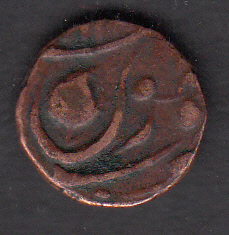
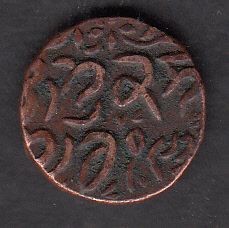


Maharaja Ranbir Singh meets the Viceroy.
Maharaja Gulab Singh

This tattered revenue document in my collection is from the Maharaja Gulab Singh period.

Some nice old and new stamps from Kashmir



The pride of my Kashmir collection are two very old Qaserah coins (also spelt Kasera).★INDIA ANCIENT “KASHMIR SULTAN” 1 KASERAH Rare Coin★
SULTANS OF KASHMIR
COIN STRUCK IN THE NAME OF SIKHANDAR SHAH C. AH 923 / AD 1517 Ref.: K72
Denomination: Kaserah Composition: COPPER Diameter: 17.42 mm, 17.51 mm
Weight: 5.4 gram, 5.3 gram Obv: al sultans al-a ‘zam sikandar shah
Rev: Mint and date written out Date: 8(7)4 (fixed date)
NR 48; R 2773
THE SULTANS OF KASHMIR
AH 747 – 994 AD 1346 – 1586
The following brief history and chronology is based on the latest numismatic research by Nicholas Rhodes and published in Numismatic Digest, Vol.17 1997, IIRNS, Nashik.
Islam was introduced into Kashmir early in the fourteenth century AD by Shah Mirza, an adventurer from Swat. He became a minister to the ruling Hindu ruler and eventually succeeded in usurping the throne around AH747 (AD 1346/7), adopting the titles Shams al-din shah. His reign lasted three years and he was followed in turn by each of his four sons’ amshid, ‘Ali Sher, Shirashamak (Shihab al-Din) and Hindal (Qutb al-Din). In AH 970 (AD 1562-1563), Muhammad Ghazi was too infirm to continue ruling. He was removed by his brother Husain Chak, who ascended the throne with the name of Husain Shah. He was not, however, to remain master of his own destiny in view of the growing Mughal power. There was also significant religious dissension within the state.Akbar sent an envoy to Kashmir in AD 1568, who was well received. When the envoy returned to Lahore, Husain sent his own daughter, with fine gifts, to be married to Akbar. Various coins struck in the name of Akbar attest to these events. Husain shah abdicated in favour of his brother, ‘Ali Chak, who ascended the throne with the title Zahir al-Din Muhammad ‘Ali Shah in Ad 1570 (AH 978). At first he attempted to assert his independence but it was not long before Akbar sent two powerful ambassadors to Kashmir to require him to acknowledge Mughal Over lordship. Coins are known struck in Akbar’s name during this reign, though not from the time of the ambassadors’ arrival.Muhammad ‘Ali died suddenly from an accident in AD 1579 (AH 987) and this led to a period of confusion. He was succeeded initially by his son Muhammad Yusuf Shah, but this latter was soon ousted as a result of a rebellion by the sayyid faction that saw Mubarak Khan ascend the throne as Mubarak Shah. He, in turn, was displaced by the counter rebellion, that saw not Yusuf but his cousin Lohar Chak seizes the throne. At this, Yusuf left Kashmir and sought Akbar’s aid to Regan his throne. A promise of aid was given but, in the event, was not needed as Yusuf managed to defeat and capture Lahore in battle. He resigns lasted for some six years but he was always mindful of pressure from the Mughal. In AD 1584 he sent his eldest son Ya ‘qub to akbar with fine gifts as proof of his loyalty, but the mission was not well received as Akbar expected Yusuf to come in person. Oddly enough, coins are known in the name of Ya’qub from that year, two years before he formally claimed the throne. In AD 1586 (AH 994), Yusuf was forced to submit to Akbar. He was imprisoned for his pains and then exiled to Bihar where he died in 1592. Resistance in Kashmir against the Mughal continued. Ya ‘qub was declared king and continued to fight a rearguard action for two years before realising that further resistance was futile. Later that year (1586) or soon after, he submitted to Akbar and, from then on, Kashmir became part of the Mughal Empire.



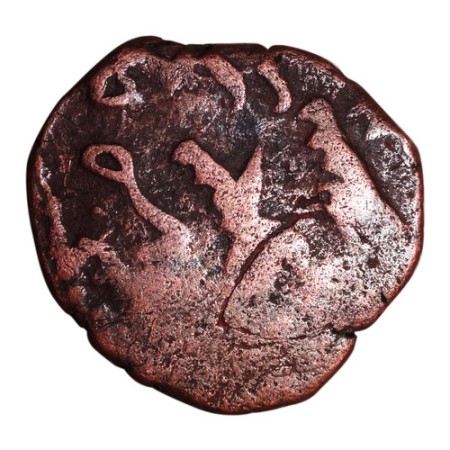
Card showing Dak Runners of Kashmir

Fabrics exported from Manchester to Calcutta were sold in Kashmir. A roll of Fabric usually had an indicative label. One such label showing Jammu Darbar and the Maharaja on the throne :

